
a web page by Don Roberson |
 |
|||
CUCKOOS & ALLIES Cuculidae Cuckoos, coucals, couas, malkohas, anis, roadrunners, ground-cuckoos & allies |
|||
|
|||
The three cuckoos mentioned represent different subfamilies. The variation among the Cuculidae ranges from parasitic songsters that lay eggs in the nests of other birds (the classic Old World cuckoo) to rangy ground-feeders in the New World to secretive skulkers whose gurgling "water-bottle" calls dominate an African swamp. This diversity supports the feeling among some that these wonderfully strange birds might better be separated into several families. |
|||
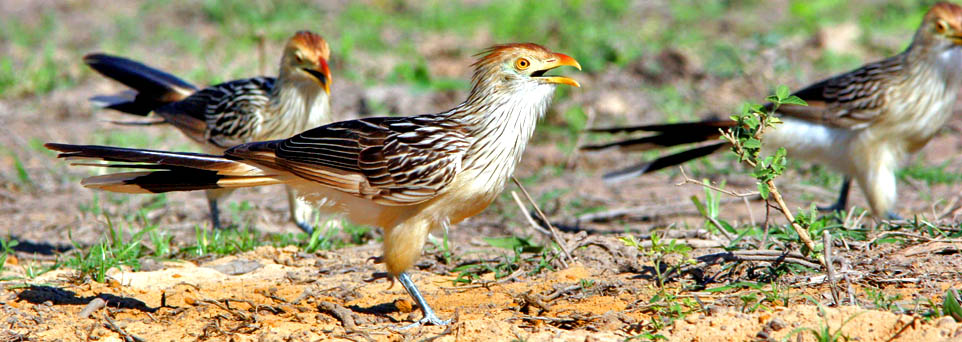 |
|||
The other major question is how many families to create out of the diversity in the Cuculiformes. Sibley & Ahlquist (1990) and Sibley & Monroe (1990) settled on five families but the Handbook of the Birds of the World account (Payne 1997) considers these five groups to be subfamilies, and further separates the malkohas and couas as another subfamily, making six subfamilies in all. Then the malkohas and the couas are given "tribe" status, thus forming at least seven distinctive groups of cuckoos. I recommend that birders learn all seven groups, and that you search for each as you enjoy birding the world. Here are the HBW six subfamilies:
Prum et al. (2015) matched molecular evidence with fossil evidence to construct a phylogeny of modern birds. Their evidence showed that the Old World subfamily Cuculinae diverged from the New World Coccyzinae group about 22 million years ago (mya) and that the combined clade of Old and New World cuckoos diverged from the Coucals about 32 mya. Thus the Coucals are the most ancient lineage, and some recent publications treat them as a separate family again (e.g., Beehler & Pratt 2016). There are also plenty of questions at species level taxonomy. "Burchell's" White-browed Coucal (right or above right) is considered just a subspecies or southern color morph of the widespread White-browed Coucal Centropus superciliosus by a number of African authorities (Fry, Keith & Urban 1988; Payne 1997) but Sibley & Monroe (1990) wrote that "the relationship in the area of overlap is uncertain; both forms occur together and represent an advanced state in the speciation process." They considered them separate species, a position followed by Clements (1991) but reversed in Clements (2000). This topic remains controversial today. There are currently 28 species of coucals in the Old World, and while there are species in Africa and Australasia, the center of diversity appears to be southeast Asia, the Greater Sundas, and the Philippines. Shown below (left) is Black-faced Coucal, a secretive species on Mindanao and nearby Philippine islands. It is dressed in a pale buff with chestnut wings and back and black tail, but the heavy majority of coucals are mostly black. An all-black, long-tailed bird with chestnut back and wings is the most common combination, like that worn by this Madagascar Coucal (below right), drying itself after a soaking rain. About a half-dozen coucals are simply entirely black. Some coucals, like Black-faced, clamber through thickets, but many live in rank vegetation adjacent to swamps. |
|||
|
|||
|
|||
The Couas are another distinctive group. They are found only on Madagascar where there are nine extant species (another went extinct about 1834). All, like the Coqueral's Coua (above left) have red or blue bare skin around the eye; six of the species (including Coqueral's) are terrestrial. In these respects, they remind me of the ground-cuckoos of the New World. During a November 1992 tour of Madagascar, we saw all nine species and I really got to like couas. The Running Coua Coua cursor of southwestern Madagascar ran across the back-country roads, as do roadrunners out here in the American West. Many species, though, require thick habitats and can be harder to see. This Red-capped Coua (above right) cautiously walked out of the underbrush for a sunbath on a forest path. Just look at the subtle change of iridescent colors on the rump and tail. |
|||
|
|||
The Common Cuckoo shown at near right is typically gray male from a population in China. To the far right is a 'hepatic' (rufous) morph female in its first autumn. Females of this and other Cuculus species often have gray morphs and hepatic morphs. This particular hepatic morph female represents California's first and only record of this Old World species. Long-distance migration can sometimes spin off vagrants on the 'wrong' side of the Pacific. There are a handful of records of Common Cuckoo and Oriental Cuckoo C. optatus in Alaska, but this one was found by friends (Lois Goldfrank, Steve Gerow) at Watsonville, in nearby Santa Cruz Co., and lingered from 28 Sep–2 Oct 2012. |
|||
Almost all parasitic birds in the Old World are host-specific, that is they generally focus on a specific species or set of species, and have evolved major host-parasite interrelationships. In Africa, Great Spotted Cuckoo Clamator glandrius — quite a large cuckoo — focuses mainly on Pied Crow Corvus albus. The cuckoo's range extends north into the Middle East, where the host is mostly the 'Hooded' Crow C. corone, and into Europe, where the host is often Black-billed Magpie Pica pica; Fry, Keith & Urban (1988). The Red-chested Cuckoo Cuculus solitarius —a mid-sized cuckoo — searches out nests of robins and small thrushes. Klaas's Cuckoo (left), an even smaller bird, is hosted mainly by sparrows and sunbirds. Levaillant's Cuckoo (below) — quite a large cuckoo of arid woodlands— parasitizes mostly Turdoides babblers, such as Arrow-marked Babbler T. jardineii, but also uses Chestnut-bellied Starling Spreo pulcher as a host. These hosts are resident in the dry country but they breed in the wet season, and that is when Levaillant's Cuckoo arrives. After the wet season it is an intra-continental migrant back to the equatorial primary forests. |
|||
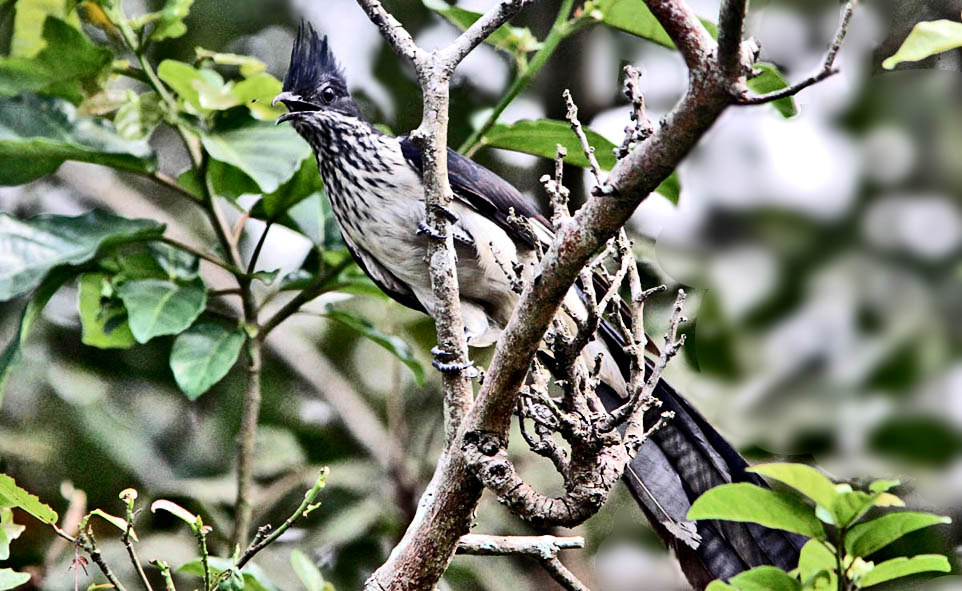 |
|||
|
|||
Before leaving African species, I did want to mention Yellow-throated Cuckoo (above; both shots of the same male). Unlike the many migratory cuckoos in Africa, this is a resident bird in the canopy of primary forests in west Africa and the Congo Basin. It is rare and little known; it is presumed to be parasitic but as of Payne (1997), its hosts were unknown. I've seen it twice: one in thick jungle in eastern Gabon, where the guides considered it the "bird of the trip," and once in southwestern Ghana (this bird, above). Not only does it have a striking black-and-yellow head/breast coloration, but it has white outer rectrices with black subterminal bars, giving a tail pattern that recalls honeyguides. Its song is a "flute-like whistle of 9-12 notes on same pitch, first the longest, accelerating and fading away. ... Sings all year" (Payne 1997). I was very fortunate to obtain photos of this scarce bird. In Australasia, Fan-tailed Cuckoo (below left) — a smallish cuckoo — relies primarily on scrubwrens and fairy-wrens as hosts. It is part of a suite of species that includes Chestnut-breasted Cuckoo Cacomantis castaneiventris and Brush Cuckoo C. variolosus (sometimes further split as Rusty-breasted Cuckoo C. sepulcralis) that dominate the aural landscape in forests from the Malay Peninsula and Greater Sundas to New Guinea and tropical Australia. On trips to islands within Malaysia, Indonesia, or Papua New Guinea the birder hears one of these species singing all day long in season — and based on that they appear to be quite common — but only rarely is one glimpsed. The very small Little Bronze-Cuckoo (below right) is one of a set of five small and patterned bronze-cuckoos in Australasia. It is brood-parasite of gerygones; this photo is from Sulawesi, so here that would be Flyeater Gerygone sulphurea. |
|||
|
|||
This species is a recent split from Fork-tailed Drongo-Cuckoo Surniculus dicruroides. Both were previously lumped as "Asian Drongo-Cuckoo" in southeast Asia. The Square-tailed, however, is the only one to reach Palawan, the south-easternmost of the Philippine Islands. In the rest of the Philippines the resident is Philippine Drongo-Cuckoo Surniculus velutinus. A final drongo-cuckoo inhabits the Moluccas. New Guinea has specialty cuckoos that are scarce and little known, including Long-billed Cuckoo Rhamphomantis megarhynchus, White-crowned Koel Caliechthrus leucolophus, and Dwarf Koel Microdynamis parva. More widespread in south Asia and Australasia are three species of Eudynamys koels. Then there is the very impressive Long-tailed Koel Eudynamys taitensis of New Zealand. It parasitizes endemic songbirds in New Zealand but then migrates to South Pacific islands for the non-breeding season. It has a huge, long tail which is very impressive in flight. Many species of parasitic cuckoos are highly migratory, but the evolution of this bird's route to remote Polynesian islands is something special. The Channel-billed Cuckoo Scythrops novaehollandiae is a huge bird with a toucan-like bill. In the austral summer it searches out nests of crows, currawongs and Australian Magpies; in the austral winter it moves to the lowland forests of New Guinea, searching for figs. From personal experience, I can say this is just one more spectacular cuckoo! |
|||
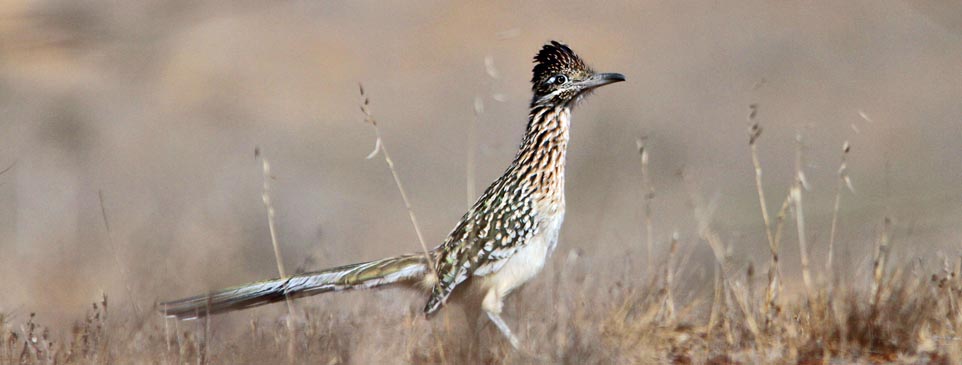 |
|||
In the New World tropics there are several other cuckoos that are terrestrial, all of which have powerful legs for life on the ground. They all have blue or red bare skin around their eyes (Greater Roadrunner has both blue and red bare skin around its eyes).The northernmost of these is the Lesser Ground-Cuckoo (right in a shot by Marc Fenner) of Central America, a species which is usually very hard to see. Even more elusive are four spectacular South American species in the genus Neomorphus; a sighting of any one of them would be a prime highlight of any visit. Some follow army ant swarms; all are rare and local. Here (below) is Kevin Zimmer's gorgeous photo of the ant-following Rufous-vented Ground-Cuckoo from Panama. |
|||
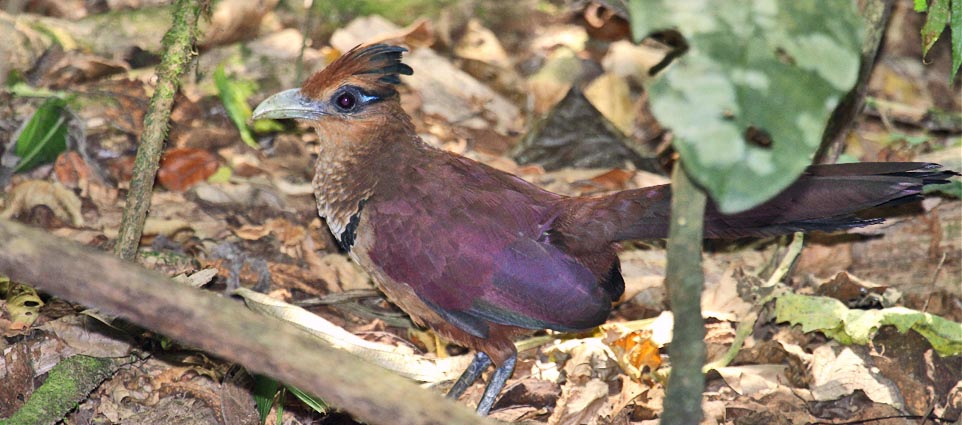 |
|||
|
|||
There are four species of lizard-cuckoos in the Caribbean, almost all are single-island endemics and each has a dramatic long and impressive tail, and an equally dramatic long bill. This is Puerto Rican Lizard-Cuckoo (above right). In Central & South America, Squirrel Cuckoo Piaya cayana is common and do seem "squirrel-like" as they move through the canopy. A very small version is Little Cuckoo (left). Several South American cuckoos are migratory, moving to the equator in the southern winter (our summer). One of these is Ash-colored Cuckoo C. cinereus. In July 1975, I discovered this tiny cuckoo on the banks of the Amazon River at Leticia where it proved to be a first record for Colombia (Hilty & Brown 1986). It was one of my best personal finds, even though I didn't know what it was at the time. I showed the bird to others and together we sorted it out using Meyer de Schauensee (1966). |
|||
|
Smooth-billed and Groove-billed C. sulcirostris anis are very widespread species in the neotropics, and both reach north into the United States in south Florida and south Texas, respectively. Smooth-bills, though, have become quite scarce and hard to find in Florida; Groove-bills are interesting because vagrants can turn up widely throughout the U.S. (I have chased three in California and finally got the third one). A recent survey on their U.S. status, plus good identification points, is in Mlodinow & Karlson (1999). The other ani — the yellow-eyed Greater Ani C. major — and Guira Cuckoo are only in South America, favoring, respectively, marshy edges and dry brushy country. |
|||
 |
|||
Photos: The flying African Cuckoo Cuculus gularus at Kalkapa, Ghana, on 29 Nov 2013. The Pavonine Cuckoo Dromococcyx pavoninus was at Intervales NP, Brazil, on 31 July 2010. The party of Guira Cuckoo Guira guira (at the top) and the lone bird (bottom of page) were both taken at Porte Jofre, Pantanal, Brazil, on 21 July 2010. The White-browed (Burchell's) Coucal Centropus [superciliosus] burchellii was taken from a blind in Kruger Nat'l Park, South Africa, in July 1996. The Black-faced Coucal Centropus melanops was at Rajah Sikatuna Park, Bohol, Philippines on 20 Dec 2005. The drying Madagascar Coucal Centropus toulou was at Berenty, Madagascar, on Nov 1992. The Coqueral's Coua Coua coquereli was peering out from the undergrowth at Ankarafantsika, Madagascar, on 29 Nov 1992; the Red-capped Coua Coua ruficeps was also there that same day. Blake Matheson photographed the Red-crested Malkoha Phaenicphaeus superciliosus at Mt. Makiling, Luzon, Philippines, on 10 Dec 2005. Dan Singer shot the Coral-billed Ground-Cuckoo Carpococcyx renauldi at Khao Yai NP, Thailand, in Feb 2012. Uncredited photos © Don Roberson. Credited photos © Blake Matheson, Dan Singer, Marc Fenner, Kevin Zimmer, and Sarah Hamilton of Big Sur Ornithology Lab, as credited, and used with permission; all rights reserved. Family book:
Literature cited:
|
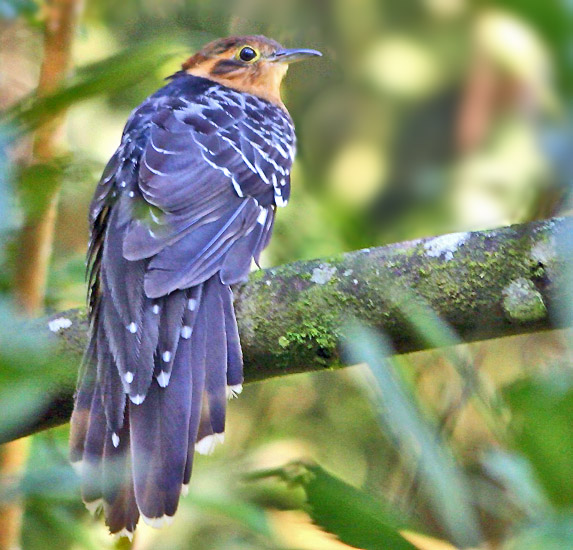 The
Cuculidae is a diverse family of mid-sized to largish birds found in
wooded habitats, savannas, or marshes around the globe. Cuckoos thrive
on all continents except Antarctica. Most occur in the tropics and are
resident but some are highly migratory, breeding in temperate habitats
far to the north or south. The African Cuckoo (above)
is an intra-continental migrant in Africa, moving long distances
between wet season breeding sites and more tropical non-breeding areas
in the dry season. Many cuckoos are secretive and hard to find;
vocalizations are often the key indicator of their presence. The Pavonine Cuckoo of tropical South America (left) is a large and impressive cuckoo but shy and elusive. In contrast, parties of Guira Cuckoo (below) are loud and conspicuous in open grasslands and pampas throughout the southern half of South America.
The
Cuculidae is a diverse family of mid-sized to largish birds found in
wooded habitats, savannas, or marshes around the globe. Cuckoos thrive
on all continents except Antarctica. Most occur in the tropics and are
resident but some are highly migratory, breeding in temperate habitats
far to the north or south. The African Cuckoo (above)
is an intra-continental migrant in Africa, moving long distances
between wet season breeding sites and more tropical non-breeding areas
in the dry season. Many cuckoos are secretive and hard to find;
vocalizations are often the key indicator of their presence. The Pavonine Cuckoo of tropical South America (left) is a large and impressive cuckoo but shy and elusive. In contrast, parties of Guira Cuckoo (below) are loud and conspicuous in open grasslands and pampas throughout the southern half of South America. 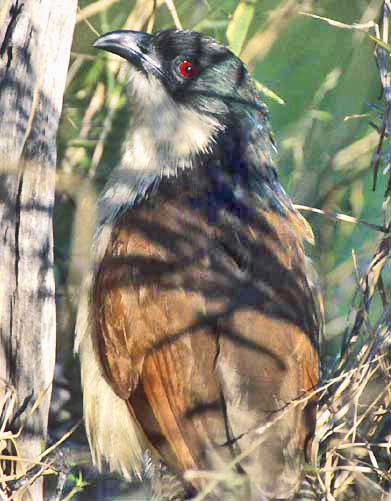 There
are issues about higher relationships within the cuckoos, but there are
some generalities as well. Nearly all are insect-eaters; a fair number
of species in both the Old & New worlds specialize in devouring
hairy caterpillars. All are long-tailed; most have powerful legs and
feet. All cuckoos have zygodactyl feet (two toes forward, two
backward). The vast majority are birds of woodlands, forests, and
jungles; most are arboreal. Many have distinctive vocalizations. It is
agreed that all the cuckoos form an Order of birds: the Cuculiformes.
Sibley & Monroe (1990) included the unique Hoatzin Opisthocomus hoazin
among this Order, but Hoatzin has anisodactyl feet (three toes forward,
one backwards) like most birds. Most recent arrangements do not include
the Hoatzin among the Cuculiformes. Prum et al. (2015) found that
Hoatzin dated back about 64 million years ago and is sister to the rest
of the landbirds, not with the cuckoos at all.
There
are issues about higher relationships within the cuckoos, but there are
some generalities as well. Nearly all are insect-eaters; a fair number
of species in both the Old & New worlds specialize in devouring
hairy caterpillars. All are long-tailed; most have powerful legs and
feet. All cuckoos have zygodactyl feet (two toes forward, two
backward). The vast majority are birds of woodlands, forests, and
jungles; most are arboreal. Many have distinctive vocalizations. It is
agreed that all the cuckoos form an Order of birds: the Cuculiformes.
Sibley & Monroe (1990) included the unique Hoatzin Opisthocomus hoazin
among this Order, but Hoatzin has anisodactyl feet (three toes forward,
one backwards) like most birds. Most recent arrangements do not include
the Hoatzin among the Cuculiformes. Prum et al. (2015) found that
Hoatzin dated back about 64 million years ago and is sister to the rest
of the landbirds, not with the cuckoos at all. 

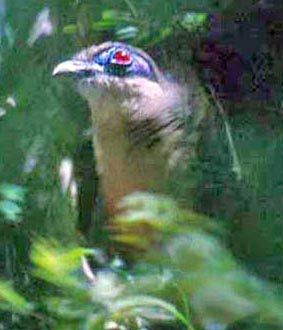
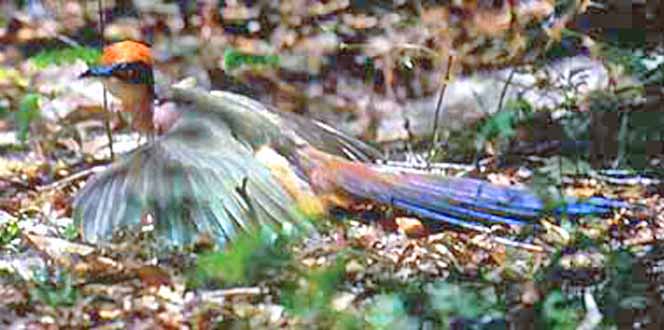
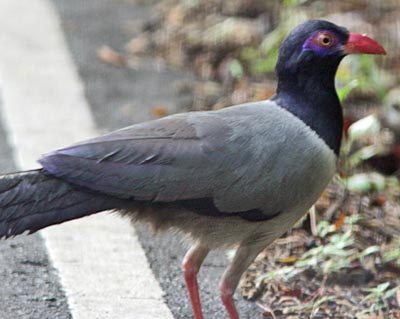
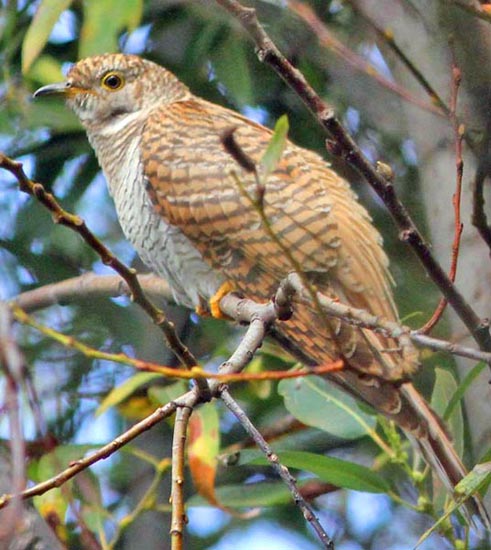
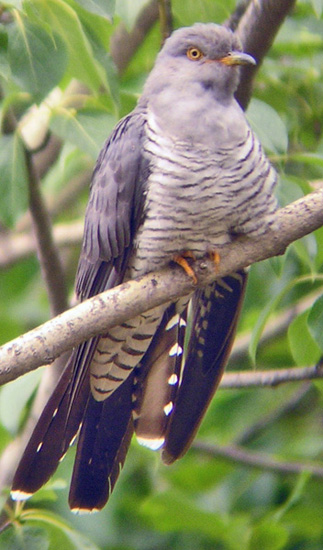 The
widespread Old World subfamily Cuculidae are about 55 species of
parasitic cuckoos. There are woodland arboreal birds that lay their
eggs in the nests of other species, forcing the duped "hosts" to
provide all the parental care. All these birds can be difficult to see
in the dense canopy, but all are vocal to some degree or another and
many are best identified by voice. The best known is Common Cuckoo
(both photos right). It breeds throughout Eurasia and gives the classic
"coo-coo" song that has been copied into cuckoo-clocks and our
subconscious. It and other Cuculus cuckoo live a parasitic
lifestyle. Leaving their young behind to be raised by others, it then
migrates long distances to winter in southern Africa or south Asia.
The
widespread Old World subfamily Cuculidae are about 55 species of
parasitic cuckoos. There are woodland arboreal birds that lay their
eggs in the nests of other species, forcing the duped "hosts" to
provide all the parental care. All these birds can be difficult to see
in the dense canopy, but all are vocal to some degree or another and
many are best identified by voice. The best known is Common Cuckoo
(both photos right). It breeds throughout Eurasia and gives the classic
"coo-coo" song that has been copied into cuckoo-clocks and our
subconscious. It and other Cuculus cuckoo live a parasitic
lifestyle. Leaving their young behind to be raised by others, it then
migrates long distances to winter in southern Africa or south Asia.  While
there is a wide diversity in plumages among the parasitic cuckoos, a
goodly number of males are clothed in gray with reddish breasts, while
many females are barred. All look "hawk-like" in flight. In the Old
World tropics there are several species that sport bronzy reflections
an another set that are emerald green. An example of the latter is Klaas's Cuckoo
(left). Parasitism has apparently evolved twice independently in Old
World cuckoos (Payne 1997). The concept of parasitism is particularly
interesting in Africa where there are not only a wide array of
parasitic cuckoos, but parasitic honeyguides which evolved from
primitive woodpecker stock and parasitic indigobirds which arose from
estrilid finch ancestors. Obviously, there are significant evolutionary
advantages in living a parasitic life-style.
While
there is a wide diversity in plumages among the parasitic cuckoos, a
goodly number of males are clothed in gray with reddish breasts, while
many females are barred. All look "hawk-like" in flight. In the Old
World tropics there are several species that sport bronzy reflections
an another set that are emerald green. An example of the latter is Klaas's Cuckoo
(left). Parasitism has apparently evolved twice independently in Old
World cuckoos (Payne 1997). The concept of parasitism is particularly
interesting in Africa where there are not only a wide array of
parasitic cuckoos, but parasitic honeyguides which evolved from
primitive woodpecker stock and parasitic indigobirds which arose from
estrilid finch ancestors. Obviously, there are significant evolutionary
advantages in living a parasitic life-style.
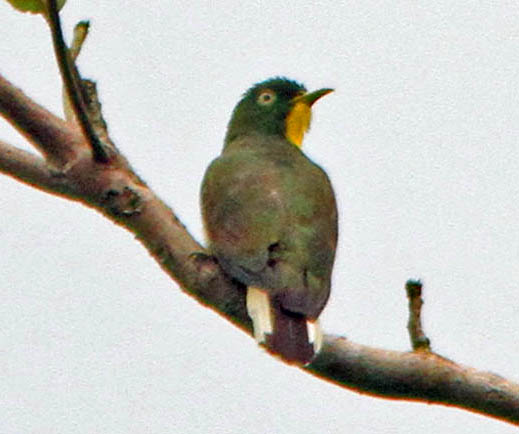
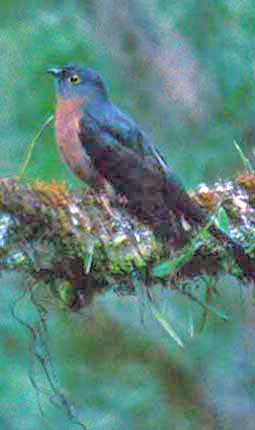
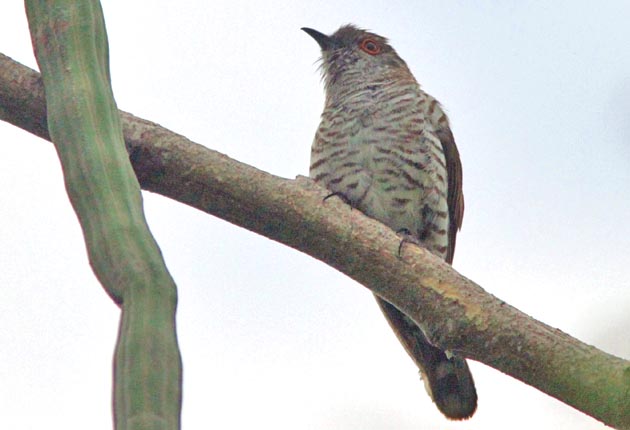
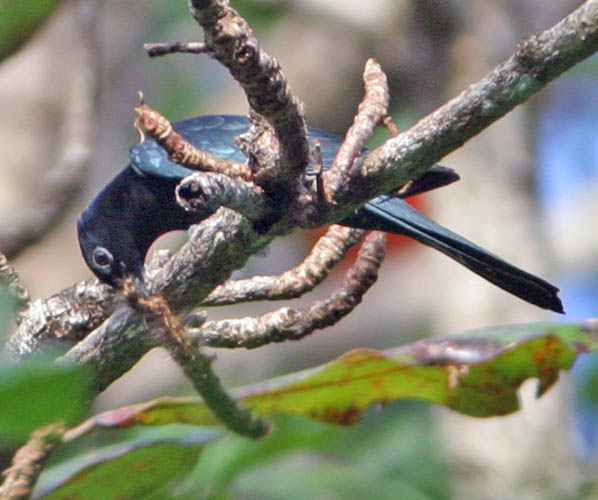 In the far East are four species of drongo-cuckoo, named for a resemblance to drongos (genus Dicurus). This (right) is Square-tailed Drongo-Cuckoo.
Notice it has a shiny plumage like a drongo. Here it looks to be
consuming a hairy caterpillar. It parasitizes a variety of bulbuls,
babblers and tit-babblers. No drongo is known to be a host.
In the far East are four species of drongo-cuckoo, named for a resemblance to drongos (genus Dicurus). This (right) is Square-tailed Drongo-Cuckoo.
Notice it has a shiny plumage like a drongo. Here it looks to be
consuming a hairy caterpillar. It parasitizes a variety of bulbuls,
babblers and tit-babblers. No drongo is known to be a host. 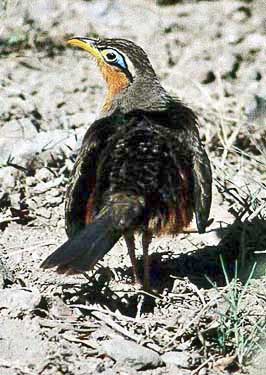 We
now turn to the three subfamilies New World. Perhaps the most
distinctive are the roadrunners and American ground-cuckoos (Sibley
& Monroe's "Neomorphidae"). These are all fascinating ground birds,
typified by Greater Roadrunner (above) of the
American West. Roadrunners eat a wide variety of ground creatures,
including snakes, lizards, and any bird it can run down. We've seen
them stalking exhausted vagrant warblers in Death Valley, California.
While characteristic of the deserts, small numbers reside in the brushy
foothills of California, and there is even a tiny population in the
maritime chaparral on Ft. Ord, next to Monterey.
We
now turn to the three subfamilies New World. Perhaps the most
distinctive are the roadrunners and American ground-cuckoos (Sibley
& Monroe's "Neomorphidae"). These are all fascinating ground birds,
typified by Greater Roadrunner (above) of the
American West. Roadrunners eat a wide variety of ground creatures,
including snakes, lizards, and any bird it can run down. We've seen
them stalking exhausted vagrant warblers in Death Valley, California.
While characteristic of the deserts, small numbers reside in the brushy
foothills of California, and there is even a tiny population in the
maritime chaparral on Ft. Ord, next to Monterey. 
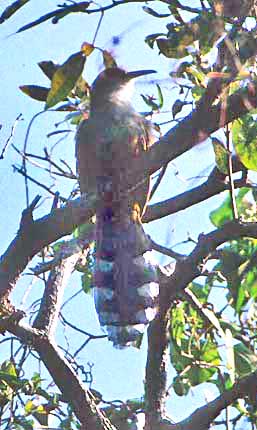
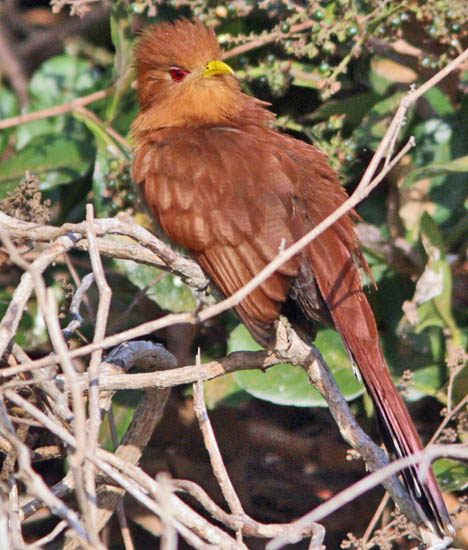 None
of the subfamily Coccyzinae — the American Cuckoos — is believed to be
parasitic. North America has two widespread and migratory species: Yellow-billed Cuckoo
of both eastern forests and southwestern riparian corridors (above, two
lefthand photos, a netted bird from California) and Black-billed Cuckoo
Coccyzus erythropthalmus, restricted to the East. I don't
usually use netted birds on these pages, but in displaying this vagrant
we can see the patterned undertail and the rufous patch in the wing,
both aspects that are hard to photograph. In California, the local
population of Yellow-billed Cuckoo has seriously declined and it is now
one of our rarest breeders (see Gaines & Laymon 1984, Laymon &
Halterman 1987). Fortunately, numbers are still decent in Arizona and
points east. On a visit to Ft. Jefferson in the Dry Tortugas we came
upon a migrant pulse of dozens of these cuckoos.
None
of the subfamily Coccyzinae — the American Cuckoos — is believed to be
parasitic. North America has two widespread and migratory species: Yellow-billed Cuckoo
of both eastern forests and southwestern riparian corridors (above, two
lefthand photos, a netted bird from California) and Black-billed Cuckoo
Coccyzus erythropthalmus, restricted to the East. I don't
usually use netted birds on these pages, but in displaying this vagrant
we can see the patterned undertail and the rufous patch in the wing,
both aspects that are hard to photograph. In California, the local
population of Yellow-billed Cuckoo has seriously declined and it is now
one of our rarest breeders (see Gaines & Laymon 1984, Laymon &
Halterman 1987). Fortunately, numbers are still decent in Arizona and
points east. On a visit to Ft. Jefferson in the Dry Tortugas we came
upon a migrant pulse of dozens of these cuckoos.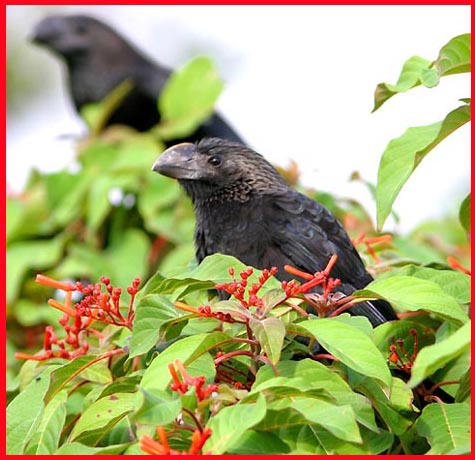 The final subfamily [Crotophaginae] consists of three species of anis (genus Crotophaga) — all of them all-black birds like the Smooth-billed Ani (right) — and one species in the genus Guira,
the Guira Cuckoo (below) which is sort-of like a blonde ani. All these
birds forage on the ground or in small bushes in small flocks. They are
communal birds that often roost together, and are co-operative
breeders.
The final subfamily [Crotophaginae] consists of three species of anis (genus Crotophaga) — all of them all-black birds like the Smooth-billed Ani (right) — and one species in the genus Guira,
the Guira Cuckoo (below) which is sort-of like a blonde ani. All these
birds forage on the ground or in small bushes in small flocks. They are
communal birds that often roost together, and are co-operative
breeders. 